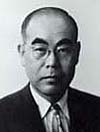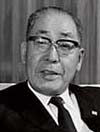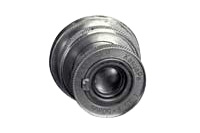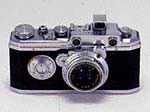1933-1936
The Birth of Canon
Japan’s first 35mm focal-plane shutter rangefinder camera was introduced into the market during this period. This all started in a small streetside shop in Tokyo, the “Precision Optical Instruments Laboratory,” to produce the prototype camera called “Kwanon,” which later evolved into the “Hansa Canon.” This is the origin of Canon’s camera making which always involves many trial and error processes. Small but steady steps for Canon cameras were initiated here.
Prelude to the Domestically Produced High-End 35mm Camera
Leica and Contax—— two great brands for the most advanced 35mm focal-plane-shutter cameras——.The “Leica Model II,” was introduced in 1932 followed by the debut of the “Contax Model I” in 1933. These cameras, the pride of Germany, the camera kingdom of the world, were considered super grade cameras satisfying the needs of camera fans throughout the world, and receiving enthusiastic support.

Goro Yoshida
(1900-1993)
In those days, the average starting salary of a graduate of an elite university in Japan who was hired by bank, the best-paying job, was around 70 yen per month. In contrast, the price of the Leica camera was 420 yen.
This high-end camera was considered to be a “takane no hana (something far beyond reach)” for ordinary people. During those years, there was a Japanese man who attempted to make the first domestic 35mm focal-plane-shutter rangefinder camera (hereafter called as the 35mm rangefinder camera) by disassembling and studying the inner workings of a “Leica Model II.” This person was Goro Yoshida (1900-1993).
Yoshida was born in Hiroshima. He came to Tokyo before completing his middle school education and apprenticed at a company repairing and remodeling motion picture cameras and projectors. During the latter half of the 1920s, when Yoshida was in his late 20s, he frequently travelled to Shanghai, China to procure the necessary parts for his jobs. A story was told that Yoshida decided to make high-grade 35mm rangefinder cameras when he met an American trader, Roy E. Delay in Shanghai, who told him:
——”Why do you come over here to buy camera parts? Your country has already produced good battleships and airplanes. If your people can produce such good battleships, there is no reason why you cannot make your own camera parts.”——
By nature, Yoshida liked to tinker with machines and instruments, and he was already engaged in repairing and remodeling motion picture cameras and projectors. It was natural that Yoshida would be attracted to the making of cameras.

Saburo Uchida
(1899-1982)

Takeo Maeda
(1909-1977)
When asked about his motives in disassembling a Leica to produce Japanese made high-grade 35mm cameras, Yoshida explained in later years:
“I just disassembled the camera without any specific plan, but simply to take a look at each part. I found there were no special items like diamonds inside the camera. The parts were made from brass, aluminum, iron and rubber. I was surprised that when these inexpensive materials were put together into a camera, it demanded an exorbitant price. This made me angry”.

The Takekawaya Building where the Precision Optical Instruments Laboratory was established
With his brother-in-law, Saburo Uchida (1899-1982) and Takeo Maeda (1909-1977), a former subordinate of Uchida, Yoshida established the Precision Optical Instruments Laboratory to develop a 35mm rangefinder camera in November 1933. The laboratory was located in a room of an elegant three-story apartment (Takekawaya Building), located in Roppongi, Azabu Ward (presently Minato Ward) in Tokyo.
Dreams for the Prototype Camera “Kwanon”
When Yoshida made his first prototype camera he named it the Kwanon, after Kannon, the Buddhist goddess of mercy, as he was a Buddhist and an ardent believer in Kannon. The camera’s logo depicted a thousand-arm Kwannon Goddess, and even its lens was named “Kasyapa” which came from Mahakasyapa, a disciple of the Buddha.
A total of three Kwanon camera variations appeared in ads but the cameras were all either an illustration or wooden models, not actual products. In other words, the “Kwanon” was never actually put on the market. Although Yoshida testified that he had completed ten “Kwanon” cameras, no one had actually seen any one of them. There was a camera called the “Kwanon Model D,” discovered in Osaka around l955, however, it was a copy of a “Leica Model II,” and was not made by Yoshida. The manufacturer of the “Kwanon Model D” is still shrouded in mystery.
Nevertheless, the manufacture of the first Japanese high-end 35mm rangefinder camera resulted from the pride and the dream of an engineer who did not want to take a backseat to Germany, or any other western nation.
Yoshida, however, left the laboratory in the fall of l934 because the approach taken by the laboratory in producing cameras was no longer consistent with what he wanted to do.

The “Kasyapa” lens named by Yoshida

“Kwanon”
Release of “Hansa Canon (Standard Model),” the First Canon Camera
In spite of the intensive trial and efforts made to commercialize the “Kwanon” camera, Precision Optical Instruments Laboratory still had no prospects to procure lenses and rangefinders, essential components of a camera. After agonizing deliberations, the laboratory decided to elicit cooperation from Nippon Kogaku Kogyo (Japan Optical Industries, Inc., the predecessor of Nikon Corporation) to use their Nikkor lens.

“Hansa Canon (Standard Model),” Canon’s first commercial camera
Nippon Kogaku, at that time, had already established its position as the largest optical equipment manufacturer in Japan with advanced manufacturing system specializing in military equipment. Since Saburo Uchida’s brother, Ryonosuke Uchida, was once an auditor at Nippon Kogaku, Saburo Uchida was introduced to Toyotaro Hori, the executive vice president and the counsel of Nippon Kogaku. Those days, under Nippon Kogaku’s policy to enter the civilian product market, Hori was in charge of studying non-military products. He was interested in the application of high-grade lenses for civilian use. The timing of the request for cooperation by Precision Optical Instruments Laboratory was perfect. Recognizing benefits on both sides, Precision Optical Instruments Laboratory and Nippon Kogaku came to an agreement to develop the “Hansa Canon (Standard Model with Nikkor 50mm f/3.5 lens)” with the full support of Nippon Kogaku.
The first Canon camera under this joint development was introduced to the market in February l936 (although some have said that the actual date was October l935). In manufacturing the “Hansa Canon,” Nippon Kogaku was responsible for the lens, the lens mount, the optical system of viewfinder and the rangefinder mechanism, while Precision Optical Instruments Laboratory was responsible for the main body including the focal-plane-shutter, the rangefinder cover as well as the assembly of the camera body.
Later, the name of the “Kwanon” was changed to “Canon,” which means “standard for judgement or biblical scriptures.” “Canon,” the new trademark for a precision industry company striving for precision as its motto, was born at this time.
When the “Hansa Canon” was released, the name of Precision Optical Instruments Laboratory was not included. Since the company did not have any sales channels, it had previously concluded an exclusive sales and trademark display agreement with Omiya Shashin Yohin Co., Ltd. (Omiya camera and accessory shop). “Hansa” was the trademark of Omiya, and was originated from the Hansa Treaty among the trade unions of Europe during the middle ages.
In June l936, Precision Optical Instruments Laboratory moved to Meguro Ward, and changed its name, to reflect the general nationalistic mood prevailing throughout the country at the time, to Japan Precision Optical Instruments Laboratory. The first time that the new company name appeared in the public media was in an advertisement for the “Hansa Canon” in the August l936 issue of the Asahi Camera.
Advance Announcement Article for “Hansa Canon”
The following article appeared in the October l935 issue of the Asahi Camera.
“Hansa Canon camera… Canon is a Leica imitation made in Japan. Although some influence of Contax is found, the majority of its features are modeled after the Leica. The dimensions of the camera are 13.5cm x 6.8cm x 4.5cm, while its weight is approximately 650g. It uses a special magazine and the lens is Nippon Kogaku’s Nikkor 50mm f/3.5. The lens is removable… The viewfinder is a box-type, and is designed to pop up to a specified position by pressing a button on the back. 275 yen with a snapshooting case included.”
Although some in the camera industry called the “Hansa Canon” a Japanese-made imitation of Leica, there was no question that it represented Japan’s first high-quality 35mm rangefinder camera. Even though it was a product of a manufacturer whose name had not yet been well recognized, the camera attracted a great deal of interest and expectations from inside and outside of the camera industry.
